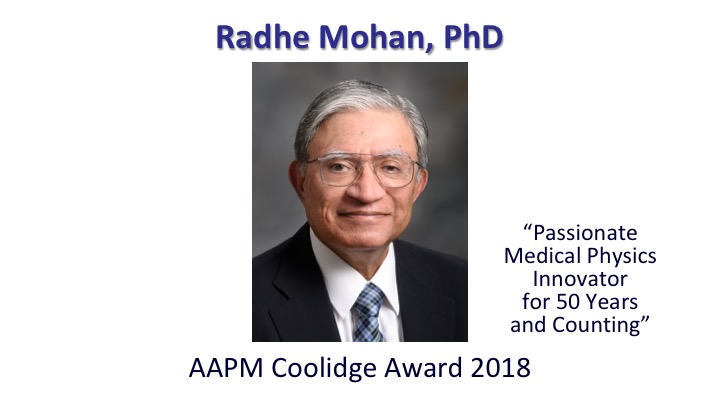
It is an honor to introduce our 2018 Coolidge Award Winner Dr. Radhe Mohan. Everybody in this room knows Dr. Mohan. But what are the characteristics that made him win the highest award of our society, in addition to many other awards over the years? I believe number one is his enormous passion for his work. Number two is his drive to innovate and change things. And number three is his unlimited energy, which has kept him going as a Medical Physics Innovator for nearly half a century and counting.

Radhe grew up in India and developed an early interest in physics. He did his BS and MS degrees in physics at Punjab University, Chandigarh. Chandigarh has an interesting history, it is one of the planned cities, designed primarily by the French architect Le Corbusier, and it has recently been named one of the perfect cities of the world.

Nevertheless, Radhe decided to leave Chandigarh and move to the US with a Fulbright fellowship. He came to Duke where he did his PhD in nuclear physics. More importantly, he met and married his lovely wife Millie (an English major) and, two years later, welcomed their son David. A few years later, they adopted their daughter Denise.

In 1971, Radhe started an enormously successful stretch of 25 years at MSKCC. His primary mission was to bring computers and programming to Medical Physics. His first project was to computerize dose measurements, and he was instrumental in developing the first record and verify system. Most importantly, he was a pioneer of dose calculation algorithms using pencil beams and Monte Carlo.

In 1982, Radhe and his group were the first target of a computer hacker attack. He worked with the FBI and helped to track the hackers.

In 1987 his team's work on 3D conformal treatment planning made it to the front page of the National Geographic Magazine.

I met Radhe for the first time in 1993, when he invited me to MSKCC to implement my inverse treatment planning algorithm in their treatment planning system. Based on that system MSKCC treated their first MLC-based IMRT patient in 1995, which started the widespread use of IMRT in the world.

After 25 years in Manhattan, the Mohans decided it was time to move to Richmond, VA, where Millie is originally from. Radhe attracted a group of enormously talented people to VCU, including Paull Keall from Australia, Jeff Siebers, and Qiuwen Wu. They did groundbreaking work on 4D CT and respiratory motion management.

The last move (for now) happened in 2002, when Radhe became the chair of the medical physics department at MD Anderson in Houston — back to a big city. There he focused primarily on advancing proton therapy and helped pave the way for its rapid growth in the US and around the world. It also brought Radhe and me together once again through the fruitful collaboration on our program project grant between MGH and MDACC.

I like this photo of Radhe. Einstein has transformed our understanding of physics. I believe you will agree with me that Radhe Mohan has transformed medical physics. Radhe, I wish to thank you personally for sharing your passion for medical physics with me and with many others in this room. The field of medical physics, radiation oncology and especially our patients owe you a lot for bringing so many innovative technologies into the clinic.
We look forward to your next developments. You are the most deserving person to receive the 2018 Coolidge award.
We have noticed that you have an ad blocker enabled which restricts ads served on this site.
Please disable it to continue reading AAPM Newsletter